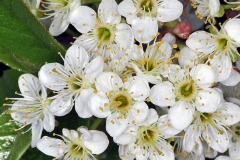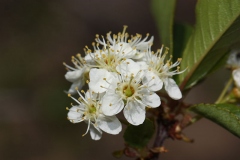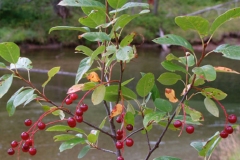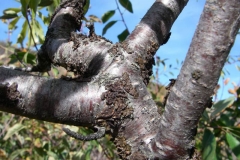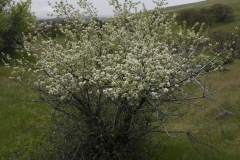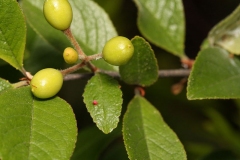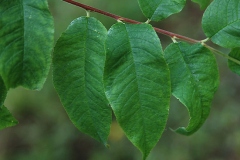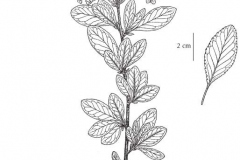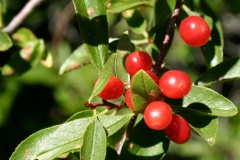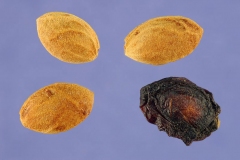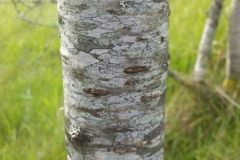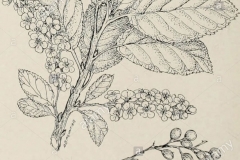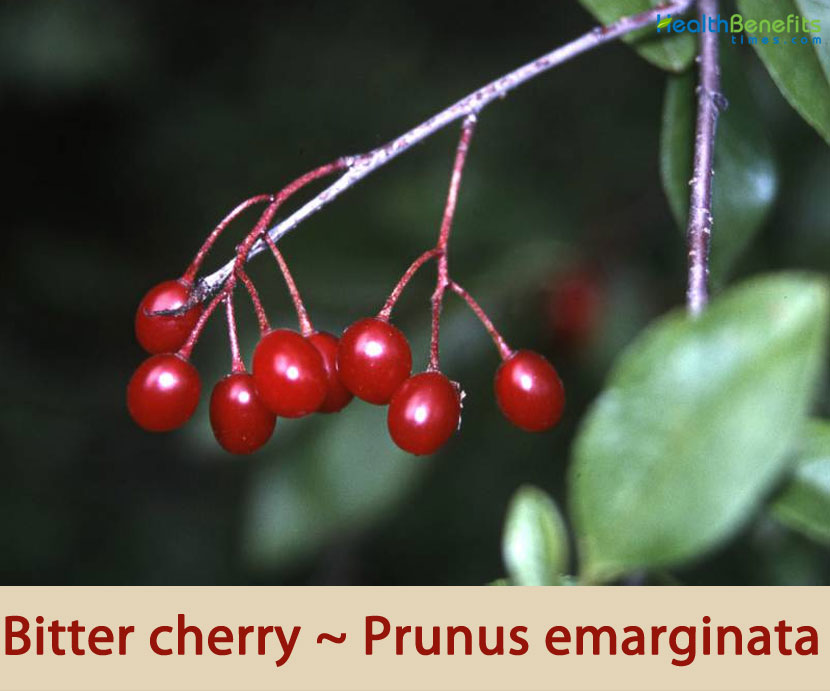
| Bitter cherry Quick Facts |
| Name: |
Bitter cherry |
| Scientific Name: |
Prunus emarginata |
| Origin |
North America, from British Columbia south to Baja California, and east as far as western Wyoming and New Mexico |
| Colors |
Red or black |
| Shapes |
Drupe like, ovoid juicy cherry 7–14 millimeters (0.28–0.55 in) diameter |
| Taste |
Bitter |
| Health benefits |
Tuberculosis, eczema, heart troubles, wounds, swellings, bronchitis, whooping cough, croup, chronic sinus inflammation and allergies |
Prunus emarginata popularly known as bitter cherry or Oregon cherry is a species of Prunus belonging to Rosaceae (Rose family). The plant is native to western North America, from British Columbia south to Baja California, and east as far as western Wyoming and New Mexico. It is often found in recently disturbed areas or open woods on nutrient-rich soil. Bird Cherry, Wild Cherry, Wild Plum, Bitter cherry, and Quinine Cherry are some of the popular common names of the plant. The plant is harvested from the wild for local use as a food, medicine and source of materials. It is sometimes grown as an ornamental.
Plant Description
Bitter cherry is an unarmed, deciduous, thicket forming shrubs or small tree with spreading to ascending branches that normally grows about 1–15 meters (3.3–49.2 ft.) tall. The bole can be 30 cm or more in diameter. The plant is found growing in moist woods, watercourses in grassland, sagebrush desert, gravelly or sandy soil along streams, rocky mountain slopes, subalpine, thickets on exposed sites, cutover and burned areas, understory of conifer and oak forests, open forest, valleys, montane, ridgelines and woodland margins. It grows best on moist, loam or sandy loam soils with good drainage, but also grows on dry, exposed sites. Roots may spread up to 50 feet (15 m) from the parent plant, sending up adventitious shoots along their length. Bitter cherry has no taproot. The bark of older trunks and branches peels horizontally, while that of younger twigs is smooth, reddish-brown, and somewhat shiny with scattered grayish red areas. The twigs are round in cross-section and 2 mm or greater in diameter.
Bitter Cherry Facts
| Name |
Bitter cherry |
| Scientific Name |
Prunus emarginata |
| Native |
North America, from British Columbia south to Baja California, and east as far as western Wyoming and New Mexico |
| Common Names |
Bird Cherry, Wild Cherry, Wild Plum, Bitter cherry, Quinine Cherry |
| Name in Other Languages |
English: Bitter cherry, Wild Cherry, Quinine Cherry
French: Cerisier amer
Germany: Bitterkirschbaum
Persian: گیلاس تلخ |
| Plant Growth Habit |
Unarmed, deciduous, thicket forming shrubs or small tree |
| Growing Climates |
Moist woods, watercourses in grassland, sagebrush desert, gravelly or sandy soil along streams, rocky mountain slopes, subalpine, thickets on exposed sites, cutover and burned areas, understory of conifer and oak forests, open forest, valleys, montane, ridgelines, and woodland margins |
| Soil |
Best on moist, loam or sandy loam soils with good drainage, but also grows on dry, exposed sites |
| Plant Size |
1–15 meters (3.3–49.2 ft.) tall. The bole can be 30 cm or more in diameter |
| Root |
Roots may spread up to 50 feet (15 m) from the parent plant, sending up adventitious shoots along their length. Bitter cherry has no taproot |
| Bark |
Bark has a generally smooth dark brown surface marked by horizontal light gray interrupted hands and by rows of oblong orange colored lenticels |
| Leaf |
Leaves are 2–8 centimetres (0.79–3.15 in) long, thin, egg-shaped, and yellowish-green with unevenly sized teeth on either side. Leaves turn yellow in the fall. |
| Flowering season |
April-June |
| Flower |
Small, 10–15 millimetres (0.39–0.59 in) diameter, with five white petals and numerous hairlike stamens; they are almond-scented, and produced in clusters in spring, and are pollinated by insects |
| Fruit Shape & Size |
Drupe like, ovoid juicy cherry 7–14 millimeters (0.28–0.55 in) diameter |
| Fruit Color |
Red or black |
| Propagation |
By Seed |
| Lifespan |
About 30-40 years |
| Taste |
Bitter |
| Plant Parts Used |
Bark, root |
| Season |
July to August |
| Varieties |
- Prunus emarginata var. emarginata.
- Prunus emarginata var. mollis (Dougl.)
|
| Culinary Uses |
- Fruit can be consumed raw or cooked.
- Seed can be consumed raw or cooked. Do not eat the seed if it is too bitter.
|
| Precautions |
-
- In small quantities, hydrogen cyanide has been shown to stimulate respiration and improve digestion, it is also claimed to be of benefit in the treatment of cancer. In excess, however, it can cause respiratory failure and even death.
|
Leaves
The leaves are long, thin, egg-shaped and from 2–8 centimeters (0.79–3.15 in) long. They are alternate on the stems, and have a pair of knob-like glands at the base. They are yellowish-green with unevenly sized teeth on either side. The upper surface of the leaf is smooth while the underside may be somewhat hairy. The margins are serrate. Leaves turn yellow in the fall.
Flowers
Flowers are small, hermaphrodite (have both male and female organs) 10–15 millimeters (0.39–0.59 in) diameter, with five white petals, 5 smaller and green sepals and numerous nearly 20 hairs like stamens. They are almond-scented, and produced in clusters in spring, and are pollinated by insects. Flowering normally takes place in between April and June.
Fruit
Fertile flowers are followed by drupe like, ovoid juicy cherry 7–14 millimeters (0.28–0.55 in) diameter, which, as the plant’s English name suggests, are bitter. They have red or purple colored thick skin and consist of single seed. As well as reproducing by seed, it also sends out underground stems which then sprout above the surface to create a thicket.
Traditional uses and benefits of Bitter Cherry
- Bitter cherry was used medicinally by several native North American Indian tribes who used it to treat a variety of complaints.
- Bark is blood purifier, cardiac, laxative and tonic.
- An infusion of the bark has been used in the treatment of tuberculosis and eczema.
- Decoction of the root and inner bark has been taken daily as a treatment for heart troubles.
- An infusion of the bark, combined with crab apple bark has been used as a cure-all tonic in treating colds and various other ailments.
- Bark, stuck on with resin, has been used as a dressing for wounds, swellings etc.
- An infusion of the rotten wood has been used as a contraceptive.
- In small amounts this exceedingly poisonous compound stimulates respiration, improves digestion and gives a sense of well-being.
- Native tribes, most notably Kwakwaka’wakw, used other parts of the plant for medicinal purposes, such as poultices and bark infusions.
- Roots and inner bark were boiled and ingested to prevent heart trouble.
- Tree is planted for land reclamation and erosion control.
- Bitter cherry is used as a remedy for coughs and for opening the lower respiratory system.
- Its sedative action is helpful for easing the cough reflex and calming irritating coughs.
- It can be used in the case of bronchitis, whooping cough, and croup.
- It is also helpful for relieving unproductive, irritating coughs that linger after an infection is over.
- It is helpful for inflammatory conditions such as acute and chronic sinus inflammation and allergies.
- Bitter cherry eliminate circulatory congestion and heat, redness, tenderness, and rapid heartbeat; together with cyanogens, which reduce cellular heat, flavonoids exert a noticeable cooling effect.
- Its sedative, anti-inflammatory, and astringent actions are helpful in calming the digestive tract, reducing inflammation and irritation, and reducing water volume in stool.
Other Facts
- Green dye can be obtained from the leaves.
- Dark grey to green dye can be obtained from the fruit.
- Bark is used to ornament baskets and is also split into strips and used for making baskets that are watertight and resist decay.
- The bark is both strong and flexible as well as being ornamental.
- Thin outer bark can be peeled off the tree in the same way as birch trees.
- It has been used to make baskets, mats, ropes and as an ornament on bows, arrows etc.
- The bark can also be made into a string.
- Wood is sometimes used for furniture because it takes a high polish.
- Wood is considered an excellent fuel.
- The flowers diffuse a soft honey scent.
- Natives used cherry bark as decoration in their basket designs.
- It was also used for wrapping the joints of many implements, such as spears, arrows and fire drills.
- Bitter cherry is used in forested riparian buffers to help reduce stream bank erosion, protect aquatic environments, enhance wildlife, and increase biodiversity.
References:
https://www.itis.gov/servlet/SingleRpt/SingleRpt?search_topic=TSN&search_value=24776#null
https://npgsweb.ars-grin.gov/gringlobal/taxon/taxonomydetail?id=29893
https://pfaf.org/user/Plant.aspx?LatinName=Prunus+emarginata
https://landscapeplants.oregonstate.edu/plants/prunus-emarginata
https://plants.usda.gov/core/profile?symbol=PREM
https://en.wikipedia.org/wiki/Prunus_emarginata
http://nativeplantspnw.com/bitter-cherry-prunus-emarginata/
https://www.fs.fed.us/database/feis/plants/tree/pruema/all.html
https://www.cabi.org/isc/datasheet/44280
http://temperate.theferns.info/plant/Prunus+emarginata
http://www.narc.gov.jo/gringlobal/taxonomydetail.aspx?id=29893
https://gd.eppo.int/taxon/PRNEM
http://www.theplantlist.org/tpl/record/tro-50317410
https://plants.usda.gov/plantguide/pdf/cs_prem.pdf
Comments
comments



